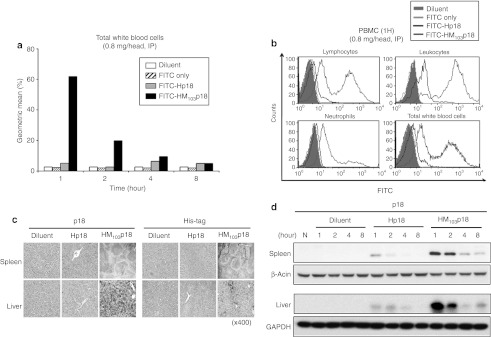Figure 4.
Systemic delivery of cell-permeable p18INK4c. (a) Uptake of fluorescein isothiocyanate (FITC)-labeled proteins by white blood cells. Mice were injected intraperitoneal (i.p.) with diluent, 20 µg FITC or 800 µg of FITC-Hp18, or FITC-HM103p18 and at the indicated times, WBCs were analyzed by flow cytometry. The geometric means of FITC fluorescent peaks are plotted. (b) Uptake of FITC-labeled proteins by WBC subpopulations. The experiment was performed as in (a) except WBC subpopulations were analyzed after staining with phycoerythrin (PE)-conjugated antibodies to lymphocyte (B220 plus CD3), leukocyte (CD116), neutrophil (Ly6G) markers. (c) Tissue (spleen and liver) distribution of recombinant proteins. Paraffin-embedded issue sections were prepared from mice 2 hours postinjection (600 µg, i.p.) and immunostained with anti-p18INK4c antibody. (d) Persistence of Hp18 and HM103p18 proteins in spleen and liver. Mice were injected with the indicated proteins as before and at the indicated times postinjection, tissue extracts were immunoblotted with antibodies against p18INK4c, β-actin, or glyceraldehyde phosphate dehyrogenase (GAPDH).

